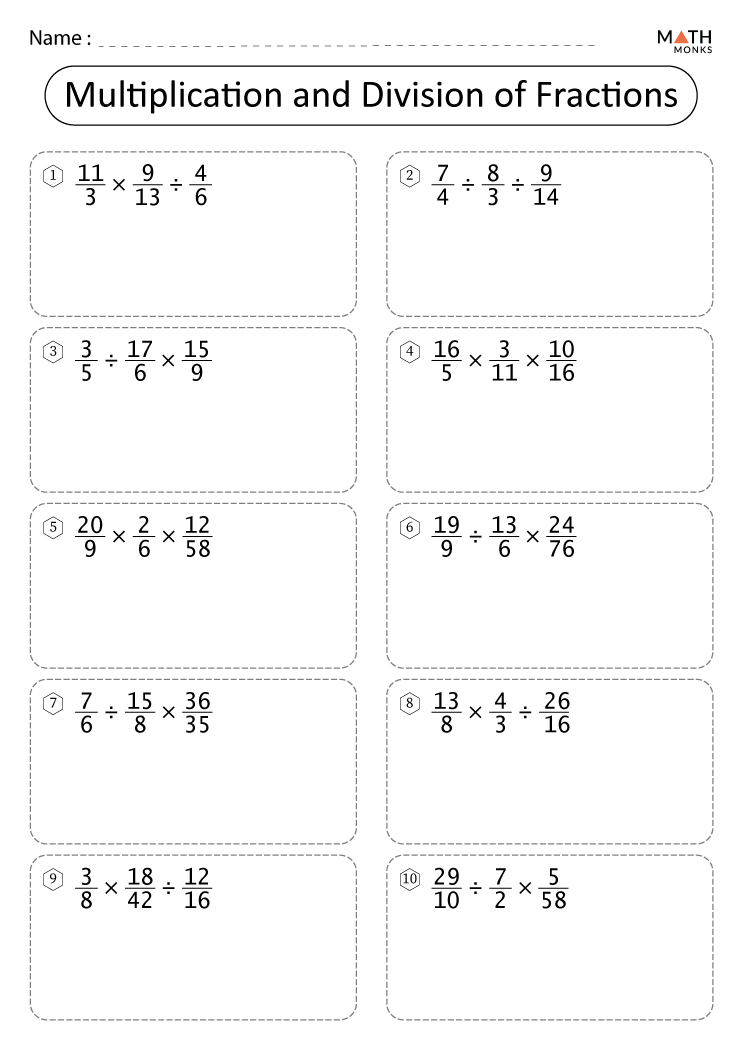Add, Subtract, Multiply and Divide Fractions Made Easy

Understanding Fractions: A Comprehensive Guide

Fractions are a fundamental concept in mathematics, representing a part of a whole. They consist of a numerator (the top number) and a denominator (the bottom number), separated by a line. Fractions can be used to represent proportions, ratios, and measurements, making them an essential tool in various mathematical operations. In this article, we will delve into the world of fractions, exploring how to add, subtract, multiply, and divide them with ease.
Adding Fractions: A Step-by-Step Guide

Adding fractions involves combining two or more fractions to form a new fraction. To add fractions, follow these simple steps:
- Step 1: Check the denominators: Ensure that the denominators of the fractions are the same. If they are not, find the least common multiple (LCM) of the denominators.
- Step 2: Convert fractions to have the same denominator: If the denominators are not the same, convert each fraction to have the LCM as the denominator.
- Step 3: Add the numerators: Add the numerators of the fractions, keeping the denominator the same.
- Step 4: Simplify the fraction (if necessary): Simplify the resulting fraction, if possible.
Example:
Add 1⁄4 and 1⁄6.
- Step 1: Check the denominators. The denominators are 4 and 6.
- Step 2: Convert fractions to have the same denominator. The LCM of 4 and 6 is 12. Convert 1⁄4 to 3⁄12 and 1⁄6 to 2⁄12.
- Step 3: Add the numerators. 3⁄12 + 2⁄12 = 5⁄12.
- Step 4: Simplify the fraction. The resulting fraction is already simplified.
📝 Note: When adding fractions, it's essential to ensure that the denominators are the same. This can be achieved by finding the least common multiple (LCM) of the denominators.
Subtracting Fractions: A Step-by-Step Guide

Subtracting fractions involves finding the difference between two or more fractions. To subtract fractions, follow these simple steps:
- Step 1: Check the denominators: Ensure that the denominators of the fractions are the same. If they are not, find the least common multiple (LCM) of the denominators.
- Step 2: Convert fractions to have the same denominator: If the denominators are not the same, convert each fraction to have the LCM as the denominator.
- Step 3: Subtract the numerators: Subtract the numerators of the fractions, keeping the denominator the same.
- Step 4: Simplify the fraction (if necessary): Simplify the resulting fraction, if possible.
Example:
Subtract 1⁄4 from 1⁄6.
- Step 1: Check the denominators. The denominators are 4 and 6.
- Step 2: Convert fractions to have the same denominator. The LCM of 4 and 6 is 12. Convert 1⁄4 to 3⁄12 and 1⁄6 to 2⁄12.
- Step 3: Subtract the numerators. 2⁄12 - 3⁄12 = -1⁄12.
- Step 4: Simplify the fraction. The resulting fraction is already simplified.
📝 Note: When subtracting fractions, it's essential to ensure that the denominators are the same. This can be achieved by finding the least common multiple (LCM) of the denominators.
Multiplying Fractions: A Step-by-Step Guide

Multiplying fractions involves multiplying the numerators and denominators of two or more fractions. To multiply fractions, follow these simple steps:
- Step 1: Multiply the numerators: Multiply the numerators of the fractions.
- Step 2: Multiply the denominators: Multiply the denominators of the fractions.
- Step 3: Simplify the fraction (if necessary): Simplify the resulting fraction, if possible.
Example:
Multiply 1⁄4 and 1⁄6.
- Step 1: Multiply the numerators. 1 × 1 = 1.
- Step 2: Multiply the denominators. 4 × 6 = 24.
- Step 3: Simplify the fraction. The resulting fraction is 1⁄24.
📝 Note: When multiplying fractions, it's essential to multiply the numerators and denominators separately.
Dividing Fractions: A Step-by-Step Guide

Dividing fractions involves dividing the numerator and denominator of one fraction by the numerator and denominator of another fraction. To divide fractions, follow these simple steps:
- Step 1: Invert the second fraction: Invert the second fraction by swapping the numerator and denominator.
- Step 2: Multiply the fractions: Multiply the fractions, following the same steps as multiplying fractions.
- Step 3: Simplify the fraction (if necessary): Simplify the resulting fraction, if possible.
Example:
Divide 1⁄4 by 1⁄6.
- Step 1: Invert the second fraction. 1⁄6 becomes 6⁄1.
- Step 2: Multiply the fractions. 1⁄4 × 6⁄1 = 6⁄4.
- Step 3: Simplify the fraction. The resulting fraction is 3⁄2.
📝 Note: When dividing fractions, it's essential to invert the second fraction and then multiply.
In conclusion, adding, subtracting, multiplying, and dividing fractions are essential mathematical operations that can be simplified by following a few simple steps. By ensuring that the denominators are the same, converting fractions to have the same denominator, and simplifying the resulting fractions, you can master the art of working with fractions. With practice and patience, you can become proficient in performing these operations and unlock a world of mathematical possibilities.
What is the least common multiple (LCM) of two numbers?

+
The least common multiple (LCM) of two numbers is the smallest number that is a multiple of both numbers.
How do I add fractions with different denominators?

+
To add fractions with different denominators, find the least common multiple (LCM) of the denominators and convert each fraction to have the LCM as the denominator.
What is the difference between multiplying and dividing fractions?

+
Multiplying fractions involves multiplying the numerators and denominators separately, while dividing fractions involves inverting the second fraction and then multiplying.
Related Terms:
- Multiplying and dividing fractions worksheets
- free fraction multiplication worksheets
- 5th grade multiplying fractions worksheets
- dividing fractions worksheet 5th grade
- division of dissimilar fractions worksheet
- division of fractions worksheets printable